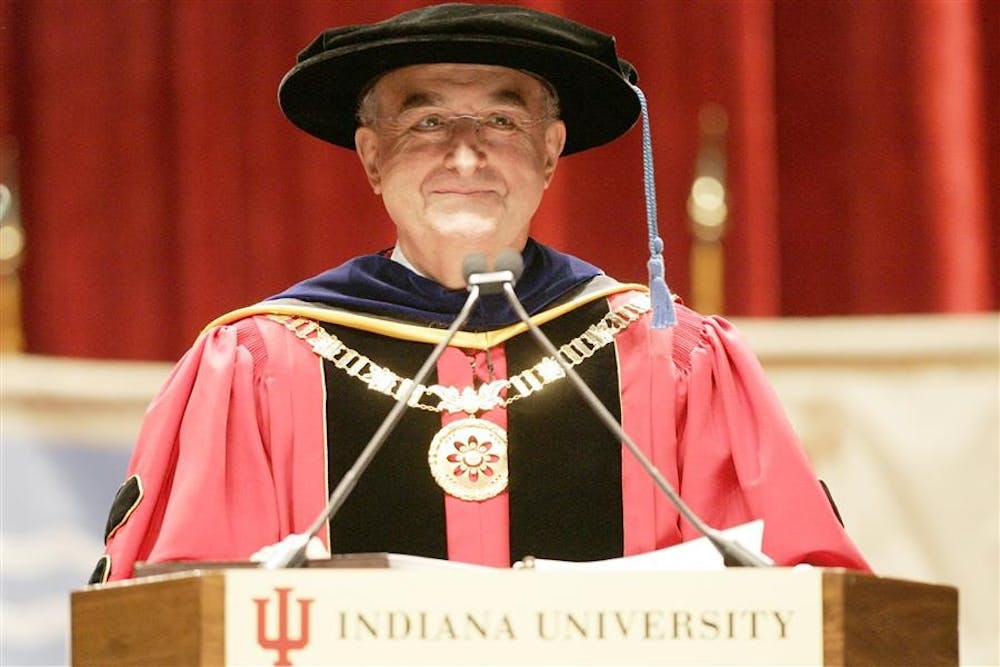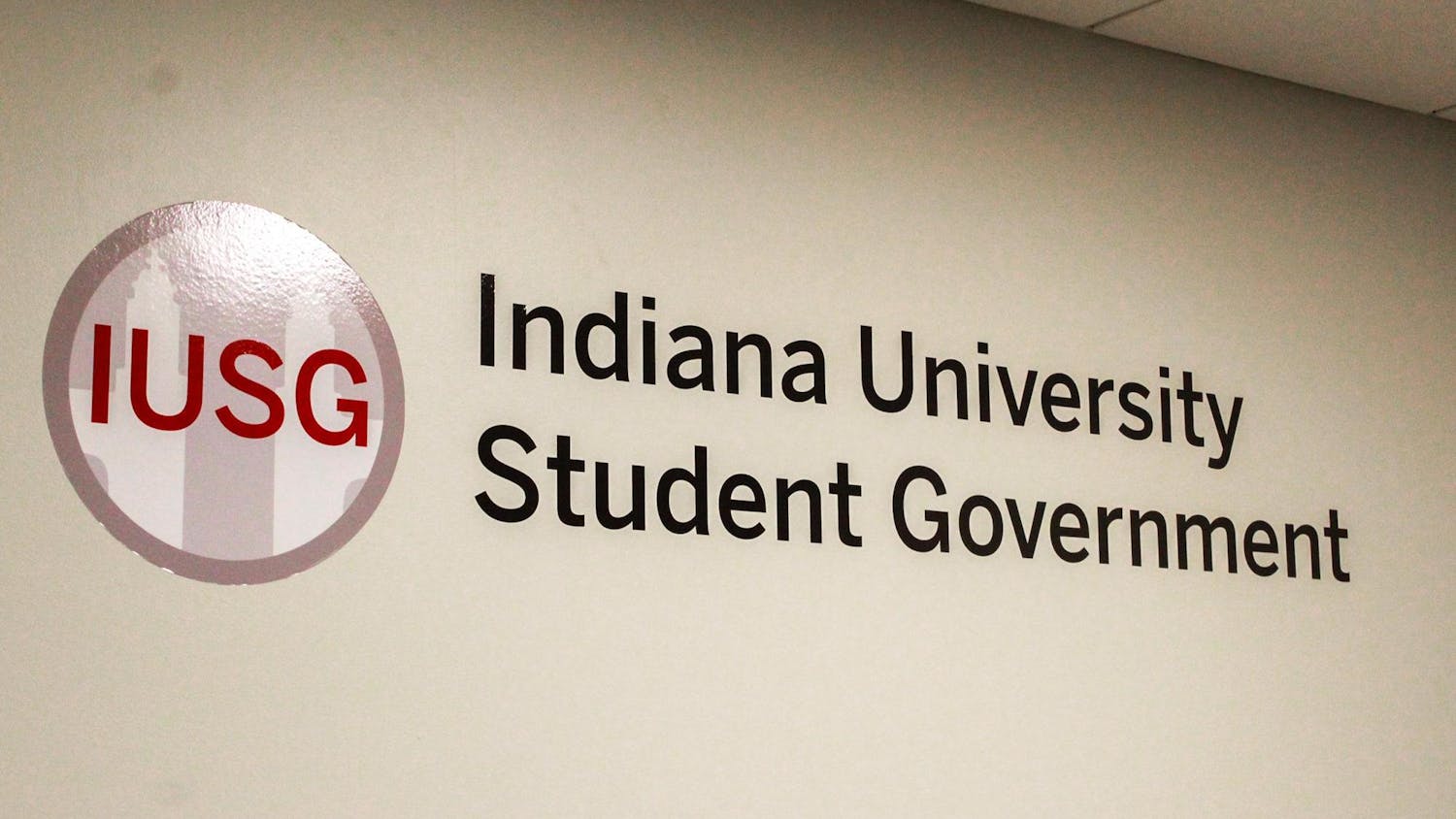IU President Michael McRobbie is aware of the shoes he has to fill. He’s surrounded by reminders — the bust of Herman B Wells in his conference room and the library that bears the legendary president’s name. But some say McRobbie has already filled them.
“We are very blessed to have Dr. McRobbie,” Trustee Philip Eskew said during a Board of Trustees meeting in July 2011. “And I hail him as IU’s modern-day Herman Wells.”
It’s difficult to compare anyone to Wells, who during his 30 years as president tripled student enrollment, expanded the University internationally, increased campus acreage from 137 to 1,700 and advocated for equal treatment of people of all races at IU. But arguably as prolific is the age of change McRobbie has implemented since he was hired in 2007.
In just seven years, McRobbie has overseen the transformation of seven schools within the University, led an acceleration in information technology and cyberinfrastructure and increased funding from big name donors to help pull IU from economic turmoil.
McRobbie takes full ownership for these changes.
“I think it all started with me,” he said, chuckling, during a recent, rare interview with the Indiana Daily Student.
It’s been an age of digitization, professionalization and consolidation brought on by two leading factors — state funding cuts and advancing technology.
But like all change, it could come at a price.
With the creation of new schools, the merging of existing ones and the elimination of others, some students, faculty and staff are fearful that the traditions and community long associated with these units are being sacrificed in the name of efficiency.
“If you keep cutting, cutting and cutting,” said Associate Professor and Herman B Wells Historian James Capshew, “you’re going to cut the heart of campus.”
***
Before the whirlwind of structural changes at IU, the University’s academic units hadn’t seen change this drastic since the early 20th century.
Adam Herbert, the president before McRobbie, only served three years before stepping down from the position, following a period of disgruntlement from IU faculty.
His lack of visibility on campus and failure to collaborate with faculty, according to news reports at the time, gave them little confidence in his ability to lead IU. At the end of 2005, the faculty called upon the Board of Trustees to review Herbert’s job performance.
In January 2006, Herbert wrote a letter to the board expressing his wish to leave the University when his contract was set to expire in July 2008.
That meant IU had more than two years to find a new president, but many institutional leaders, including some trustees, felt they couldn’t wait that long.
“What was happening in the world was that the good universities were getting better,” current Board of Trustees Chairman Tom Reilly said, reflecting on the tensions back then. “We came to several conclusions, and one was that Bloomington needed leadership.”
Before they formed a presidential search committee, though, an administrative reorganization took place at the recommendation of Herbert. Just days after Herbert penned his letter to the trustees, McRobbie, then vice president for research and vice president for information technology, was named IU’s first interim provost.
The new position replaced IU-Bloomington’s chancellor position. Before that, IU-Bloomington had a chancellor who answered directly to the Bloomington-located president, just like all IU regional campuses across the state. But it seemed unnecessary to have both the president of the University and a chancellor in Bloomington, Reilly said, so they cut the position at IU-Bloomington.
The provost’s job would be to oversee all academic entities at IU-Bloomington but allow the University president to have a stronger role in the flagship campus.
Once they filled the new provost position, a presidential search committee formed in June 2006.
Reilly and Lauren Robel, then dean of the Maurer School of Law, both served on the search committee and now hold prominent, powerful positions within IU. Reilly is chair of the Board of Trustees and Robel is provost and executive vice president.
In a recent interview, Reilly said the committee was looking for someone who was enthusiastic about collaborating with faculty, knowledgeable of the way technology was shaping education and prepared to take on the challenge of leading a 21st century public university.
“We were looking for somebody who had a demonstrated ability to conceptualize a major change effort and take it to completion,” Robel said.
They were looking for someone who would make change happen.
“Out of it came a general consensus that Michael would be the candidate,” Reilly said.
On March 1, 2007, the board unanimously appointed McRobbie as president, and on October 18, 2007, he offered his inaugural address. He referenced the legendary changes Wells implemented as a precursor to his own vision for IU.
“Indiana University’s history is a story of change in response to the demands of the time,” McRobbie said in his address. “Never was this more true than during the days of Herman Wells.”
McRobbie continued, saying Wells’ tenure at IU embodied a “golden age for American universities as a whole and for IU in particular,” but that Wells didn’t treat the University as a relic. Instead, he brought great energy and vigor to improving IU.
“IU, then, is not an institution that is a stranger to change,” McRobbie said. “Its history is one of endurance, adaptation and renewal.”
His vision was forward-thinking and clear — change was coming.
Then, just six months later, the recession hit.
***
Despite nearly $100 million in state funding cuts and a 5-percent drop in philanthropic giving, McRobbie said his administration was able to pull IU from the economic turmoil without furloughing any employees or halting any important projects.
But, he said, that involved consolidation and reorganization across campus.
In his 2009-10 State of the University speech, McRobbie announced that then-Provost Karen Hanson would lead the formation of the New Academic Directions Committee charged with evaluating the strengths and weaknesses of IU’s academic structure.
The report was completed in 2011. In 2012, when current Provost Lauren Robel was appointed, the recommendations in the New Academic Directions report got fully underway. Today, those changes define IU’s current structure:
• The creation of the Media School through merging the School of Journalism and the Departments of Telecommunications and Communication and Culture
• Elimination of the School of Continuing Studies
• Changing the School of Library and Information Sciences into a department in the School of Informatics and Computing
• Creation of the School of Global and International Studies
• Creation of the Lilly Family School of Philanthropy at IUPUI
• Creation of the Fairbanks School of Public Health at IUPUI
A self-proclaimed “huge fan of aggregation,” McRobbie said he recognized the benefits of consolidating certain departments and eliminating others in the hopes of saving money.
At the same time, he wanted to be sure the academic institutions within IU reflected the technological developments and 21st century demands of the job market.
In his opinion, it would be “immoral” to allow IU students to graduate without the real-world skills necessary to perform professionally. McRobbie himself is a supporter of the arts and passionate about film, but said it’s a University’s job to produce both academics and professionals and do it in a cost-sensitive manner.
It’s why the board hired him in the first place — to identify inefficient spending within the University and adjust it.
But Capshew said there’s a fine line many public universities walk between being a business and being a place that supports creativity and the humanities.
“I do think there is a danger in trying to professionalize the humanities unduly,” he said.
For McRobbie, it’s a balancing act.
“Fiscal pressures aren’t going to go away,” he said, acknowledging that sometimes difficult decisions must be made in the short term to benefit the University in the long run.
He has his staff keep track of the promises he makes in speeches, to hold him accountable to his own agenda. Less than five years after the New Academic Directions report was released, nearly all of the recommendations have come to fruition.
But Capshew says it’s still too early to tell whether McRobbie’s tenure as president will have as lasting an impact as Wells’.
“There will never be another Herman B Wells,” McRobbie says of his own legacy.
He just wants to leave IU 30 percent better off than when he took over. For now, the trustees have made it clear they are pleased with McRobbie’s performance, increasing his salary and extending his contract to 2020.
“You will never make an alum mad by not changing something. You will never upset a donor by leaving things exactly the way they are or a faculty member or a student, for that matter,” Robel said of McRobbie’s readiness to act. “It’s only change that will cause people to get upset.”
Those same student groups, faculty bodies and alumni boards are still waiting for answers — Are the changes working? How do we know?
Good question, Reilly said.
“The future will be the test,” Robel said.
It’s too early to tell, McRobbie said.




